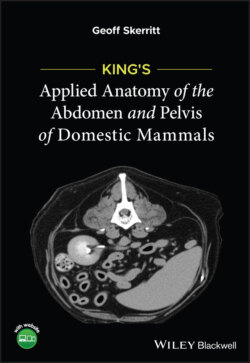Читать книгу King's Applied Anatomy of the Abdomen and Pelvis of Domestic Mammals - Geoff Skerritt - Страница 22
1.3.5 Internal abdominal oblique muscle (Figures 1.6–1.8)
ОглавлениеFigure 1.6 Lateral view of inguinal area of horse showing the internal abdominal oblique muscle. The left external abdominal oblique muscle has been removed although the position of the left superficial inguinal ring is shown. The mid‐section of the left cremaster muscle has been excised to expose the vaginal tunic.
Figure 1.7 Ventral view of inguinal region showing internal abdominal oblique muscle.
Figure 1.8 Lateral view of abdomen of ox showing left abdominal oblique muscle. The external abdominal oblique has been removed.
Origin: Tuber coxae and lumbodorsal fascia.
Insertion: Linea alba (except for the most caudal part), last rib and cartilages of the caudal ribs.
Structure: This is a sheet of muscle and tendon with the fibres running cranioventrally. It is muscular at its origin and becomes tendinous ventrally. In the male a slip of the internal abdominal oblique muscle passes through the inguinal canal on the lateral aspect of the vaginal process and becomes the cremaster muscle (see Section 16.4).
Species variations: The fibres of this muscle run almost ventrally in the dog. In carnivores the tendinous portion divides to pass dorsally and ventrally to the rectus abdominis muscle in the cranial third of the abdomen; it passes only ventrally in the caudal two‐thirds of the abdomen. In the ox the internal abdominal oblique is quite substantial, being the largest flank muscle in this species; its tendon passes both ventrally and dorsally to the rectus abdominis. In the horse the internal abdominal oblique muscle originates only from the tuber coxae, and its tendon passes ventrally to the rectus abdominis. See Figures 1.10a–c for a summary of the species variation of the sheath of the rectus abdominis.
